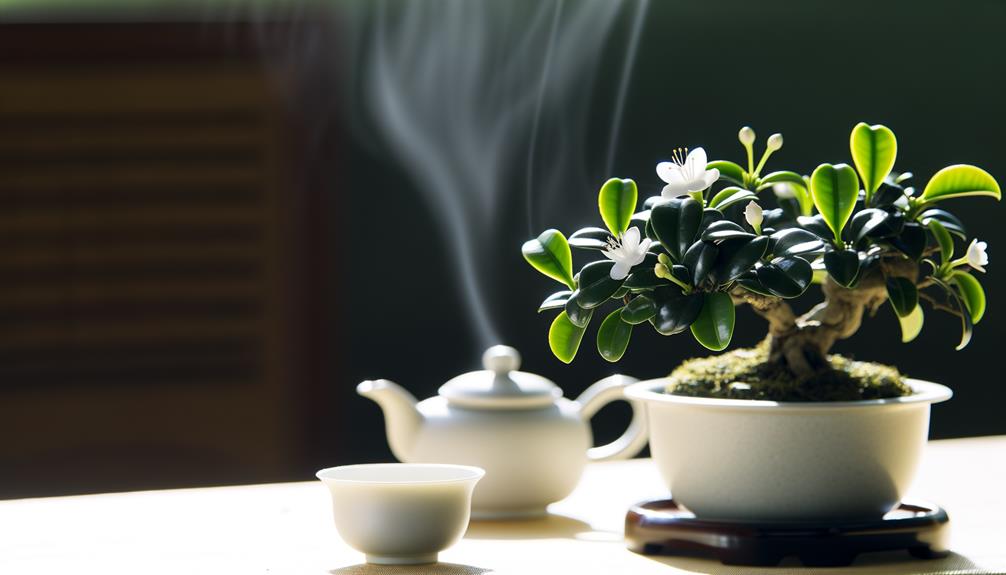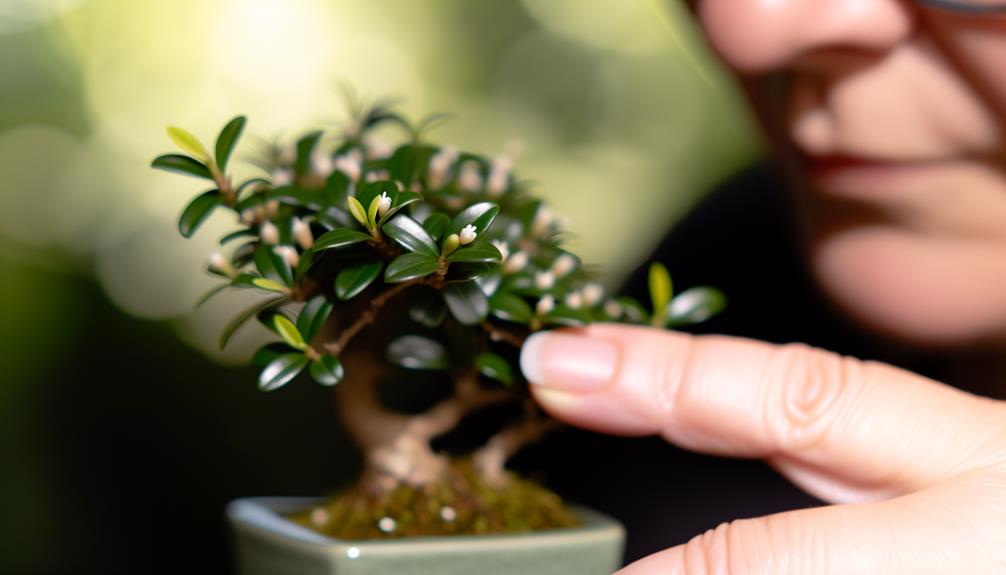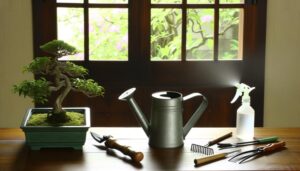How You Make Tea with Fukien Tea Bonsai
Yes, it is feasible to brew tea from the leaves of the Fukien Tea Bonsai (Ehretia microphylla). This evergreen shrub, originating from Southeast Asia, has long been utilized for its medicinal properties, particularly in treating gastrointestinal and respiratory ailments.
The leaves contain bioactive compounds with antioxidative, anti-inflammatory, and antimicrobial effects. For best tea preparation, precise control of water temperature and accurate leaf-to-water ratio are essential.
The resulting infusion typically displays a pale amber hue with earthy undertones. To explore the full spectrum of its historical usages and preparation techniques, further detailed information is available.

Key Takeaways
- Yes, the leaves of the Fukien tea bonsai can be used to make tea.
- The leaves contain bioactive compounds with antioxidant, anti-inflammatory, and antimicrobial properties.
- Proper brewing techniques include controlling water temperature and steeping time for optimal flavor.
- The tea has an earthy taste profile with astringent undertones.
- Historically, Fukien tea has been used for its medicinal benefits in traditional medicine.
Understanding Fukien Tea Bonsai

Understanding the Fukien Tea Bonsai necessitates a detailed examination of its botanical characteristics, including its origin, growth habits, and physiological responses to various cultivation practices. Native to Southeast Asia, particularly Fujian province in China, this evergreen shrub (Ehretia microphylla) exhibits small, glossy leaves and produces tiny white flowers.
The plant's compact size makes it suitable for bonsai cultivation. Physiologically, Fukien Tea Bonsai responds to moderate sunlight, well-drained soil, and consistent moisture levels. It thrives in warm climates but is sensitive to cold, requiring protection from frost. Pruning is essential to maintain its shape and encourage dense foliage.
Understanding these growth habits and environmental preferences is essential for successful cultivation and informs potential uses, including the prospect of making tea.
Historical Uses of Fukien Tea
Throughout history, Fukien Tea (Ehretia microphylla) has been utilized for both medicinal purposes and as a traditional beverage in its native regions. Indigenous populations in Southeast Asia and China have long revered this plant for its pharmacological properties, particularly its use in traditional medicine. Documented benefits include treatment for gastrointestinal ailments, respiratory issues, and as an anti-inflammatory agent.
The leaves, known for their distinctive, mildly astringent flavor, were often brewed into a therapeutic tea that served both as a remedy and a daily tonic. Additionally, historical texts indicate its inclusion in various herbal formulations aimed at improving general well-being. This dual role of Fukien Tea underscores its cultural significance and the empirical knowledge surrounding its health benefits.
Identifying Edible Parts

In the context of using Fukien Tea Bonsai (Carmona retusa) for brewing tea, it is imperative to identify the edible parts, specifically the leaves, and ascertain their safety for consumption.
The leaves of Carmona retusa contain various bioactive compounds which may confer certain health benefits when properly prepared.
Detailed preparation and usage guidelines must be adhered to, ensuring both efficacy and safety in the resulting infusion.
Leaves and Their Safety
Determining the safety of consuming leaves from the Fukien Tea Bonsai requires careful identification and understanding of its botanical characteristics to make sure that only non-toxic parts are used.
The Fukien Tea Bonsai, scientifically known as Carmona retusa, features small, glossy, dark green leaves. A thorough examination should confirm the absence of any contaminants or pathogens. It is vital to recognize the exact species, as misidentification could result in the ingestion of potentially harmful substances.
Studies indicate that the leaves should be thoroughly washed to remove any residual pesticides. As with any plant intended for consumption, ensuring the plant is grown organically and free from chemical treatments is essential for safety.
Proper identification and preparation are key to mitigating health risks.
Potential Health Benefits
The leaves of the Fukien Tea Bonsai, known for their distinct phytochemical properties, offer potential health benefits when properly identified and prepared. These leaves contain bioactive compounds such as flavonoids and polyphenols, which have been linked to various health-promoting effects. Research indicates that consuming these compounds may contribute to several physiological benefits:
- Antioxidant Activity: Polyphenols in the leaves may help reduce oxidative stress by neutralizing free radicals, thereby potentially lowering the risk of chronic diseases.
- Anti-inflammatory Properties: The flavonoids can modulate inflammatory pathways, which might alleviate symptoms of inflammatory conditions.
- Antimicrobial Effects: Certain bioactive constituents exhibit antimicrobial properties, which could aid in combating bacterial and viral infections.
Understanding these properties is essential for safe and effective use.
Preparation and Usage Tips
Carefully identifying the edible parts of the Fukien Tea Bonsai is essential for guaranteeing safety and maximizing the therapeutic potential of the tea. The primary focus should be on the leaves, which contain beneficial compounds. Avoid using the roots and bark, as they may contain substances that are not suitable for ingestion.
| Part | Edibility | Notes |
|---|---|---|
| Leaves | Edible | Rich in antioxidants and polyphenols |
| Flowers | Generally Avoided | Limited information on safety |
| Bark | Not Edible | Potentially harmful compounds |
| Roots | Not Edible | Contains non-beneficial elements |
Before consumption, make sure that all leaves are thoroughly washed to remove any contaminants. This approach will optimize the health benefits while mitigating potential risks.
Brewing Techniques
To achieve the finest extraction of flavors, the precise temperature of the water and steeping duration must be vigilantly controlled when brewing tea from a Fukien Tea Bonsai.
The following steps are critical:
- Water Temperature: Heat water to precisely 80-85°C (176-185°F) to preserve delicate aromatic compounds. Excessive heat can result in bitterness.
- Leaf Quantity: Use approximately 1-2 grams of Fukien Tea Bonsai leaves per 150 milliliters of water. This ratio guarantees a balanced infusion.
- Steeping Time: Steep the leaves for 3-5 minutes to achieve prime flavor extraction. Longer steeping times risk over-extraction, leading to undesirable astringency.
Monitoring these parameters enhances the sensory qualities of the tea, ensuring a refined, enjoyable experience.
Health Benefits

Consumption of tea made from Fukien Tea Bonsai leaves offers numerous health benefits, including antioxidant properties and potential anti-inflammatory effects. The leaves are rich in polyphenolic compounds, which act as potent antioxidants, neutralizing free radicals and reducing oxidative stress.
These compounds may also inhibit inflammatory pathways, thereby mitigating chronic inflammation. Additionally, the tea contains specific flavonoids, which have been shown to support cardiovascular health by improving endothelial function.
Preliminary studies suggest that the bioactive compounds in Fukien Tea Bonsai leaves may also possess antimicrobial properties, providing an added layer of immune support. Overall, the chemical composition of the leaves underscores their potential as a functional beverage with diverse health-promoting attributes.
Potential Risks
Despite its numerous health benefits, the consumption of tea made from Fukien Tea Bonsai leaves may pose certain risks due to the presence of bioactive compounds that can interact with medications or exacerbate pre-existing health conditions. These potential risks are important to keep in mind:
- Drug Interactions:
Bioactive compounds in Fukien Tea Bonsai leaves may interfere with the pharmacokinetics of certain medications, potentially altering their efficacy or causing adverse effects.
- Allergic Reactions:
Individuals with plant allergies may experience hypersensitivity reactions, including skin rashes, respiratory issues, or gastrointestinal distress.
- Toxicity:
The leaves may contain compounds at concentrations that are toxic if consumed in large quantities, leading to symptoms such as nausea or liver dysfunction.
Understanding these risks is essential for safe consumption.
Taste Profile

Having considered the potential risks associated with Fukien Tea Bonsai, it is equally important to examine the taste profile, which is characterized by its subtle, earthy undertones and a slight astringency.
The leaves, when brewed, exhibit a nuanced complexity that is both mild and distinctive. The earthy flavors are reminiscent of certain traditional Chinese teas, though less robust. Astringency, while present, is not overpowering, adding a crisp, clean finish to the overall experience.
The infusion process typically yields a pale, amber-hued liquid, indicative of its delicate flavor profile. Significantly, the precise taste can be influenced by factors such as leaf age, water temperature, and steeping duration, necessitating careful preparation to achieve the best sensory experience.
Alternative Uses
Beyond its use in tea preparation, the Fukien Tea Bonsai presents a range of alternative applications. These include potential medicinal properties, advanced bonsai crafting techniques, and diverse culinary experimentation possibilities.
Scientific studies have suggested its leaves may contain compounds with therapeutic benefits, necessitating further pharmacological investigation. Concurrently, the unique aesthetic and structural characteristics of the bonsai provide a fertile ground for innovative horticultural practices and gastronomic exploration.
Medicinal Properties Exploration
The Fukien tea bonsai (Carmona retusa) has been traditionally renowned for its potential medicinal properties, including anti-inflammatory and antimicrobial effects, which warrant a detailed exploration.
Scientific investigations into its bioactive compounds reveal several promising applications:
- Anti-inflammatory Properties: Extracts from Carmona retusa have shown significant inhibition of pro-inflammatory mediators, suggesting potential use in managing inflammatory conditions.
- Antimicrobial Activity: Studies have identified that the plant exhibits broad-spectrum antimicrobial effects, targeting both gram-positive and gram-negative bacteria.
- Antioxidant Capacity: The presence of phenolic compounds in Fukien tea contributes to its antioxidant properties, which are essential in combating oxidative stress-related diseases.
These findings underline the need for further pharmacological studies to validate and optimize the therapeutic applications of Fukien tea bonsai.
Bonsai Crafting Techniques
Mastering the intricate art of bonsai crafting with Fukien tea bonsai requires an understanding of specific horticultural techniques. This includes precise pruning, meticulous wiring, and controlled environmental conditions to shape and maintain the desired aesthetic form.
Pruning involves the selective removal of branches and leaves to achieve balance and promote health. Wiring is applied to direct growth patterns and enhance structural form, requiring careful application to avoid damage to the bark.
Environmental control is essential and involves regulated lighting, humidity, and temperature to mimic the plant's natural habitat. Soil composition, incorporating well-draining substrates, also plays a pivotal role in root development.
Mastery of these techniques not only preserves the bonsai's vitality but also accentuates its visual elegance, reflecting meticulous care and expertise.
Culinary Experimentation Possibilities
While the meticulous horticultural techniques enhance the aesthetic form and health of the Fukien tea bonsai, its leaves also present intriguing possibilities for culinary experimentation, particularly in the domain of tea infusion.
The bioactive compounds within Carmona retusa leaves offer a unique flavor profile and potential health benefits. Here are three alternative uses:
- Tea Infusion: When brewed, the leaves yield a mild, earthy tea with potential antioxidative properties.
- Culinary Garnish: The leaves can be used as a garnish, adding a subtle, herbal note to dishes.
- Herbal Extracts: Extracts derived from the leaves can be incorporated into sauces and marinades, providing a distinctive flavor and possible therapeutic effects.
These applications underscore the multifaceted utility of Fukien tea bonsai in culinary arts.
Conclusion
To sum up, understanding Fukien tea bonsai involves recognizing its historical uses, identifying its edible parts, and mastering brewing techniques.
The health benefits, potential risks, and unique taste profile of Fukien tea must be considered.
Detailed observations reveal that while alternative uses exist, the primary focus remains on its culinary and medicinal applications.
This thorough analysis provides a nuanced perspective on the multifaceted nature of Fukien tea bonsai, ensuring informed decision-making and appreciation for this botanical specimen.






